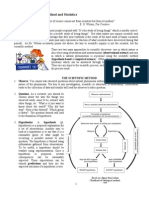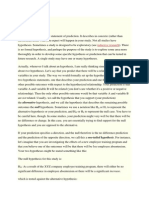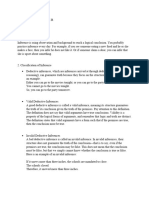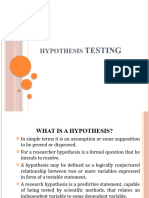Upsr Science 2010
Upsr Science 2010
Uploaded by
v_prabu83Copyright:
Available Formats
Upsr Science 2010
Upsr Science 2010
Uploaded by
v_prabu83Copyright
Available Formats
Share this document
Did you find this document useful?
Is this content inappropriate?
Copyright:
Available Formats
Upsr Science 2010
Upsr Science 2010
Uploaded by
v_prabu83Copyright:
Available Formats
UPSR SCIENCE 2010
Aim of investigation
(a) Most of the time the aim of investigation is given in the question itself. For
example:
- An investigation was carried out to find the time taken for ice cubes of
different masses to melt.
For the above question, the aim of investigation is already given in the
question itself. Why was the investigation carried out? to investigate the time
taken for ice cubes of different masses to melt (Aim of investigation)
(b) Sometimes, the question would not state the aim of investigation. In such
situation the formula below would help:
To investigate the relationship between (state the manipulated variable) and
the (state the reaponding variable
Variable
There are three type of variable;
(a) Manipulated variable : What is changed
(b) Responding variable : What is observed, note that when the manipulated
variable is changed, the responding variable changes by itself. It responds to
the manipulated variable.
(c) Constant/fixed variable : What is kept the same.
Hypothesis and conclusion
As far as upsr is concerned, the hypothesis and conclusion is the same.
Hypothesis is a theory that is tested with an experiment. If the theory is proven
right, the conclusion would be the hypothesis (hypothesis is proven right).if the
conclusion does not follow the hypothesis, then the hypothesis is wrong. Another
hypothesis must be formed and tested with an experiment. So, hypothesis is
actually a smart guess. It can be a right statement or a wrong statement.
However as far as upsr is concerned, you are trained to write the right
hypothesis .Therefore:
HYPOTHESIS = CONCLUSION
How to form hypothesis/conclusion?
You have to state the relationship between the manipulated variable and the
responding variable. For example, use words like increase, decrease, higher,
lower, bigger, smaller, etc. For example. If the experiment is to investigate the
relationship between surface area and rate of evaporation.
Manipulated variable : surface area
Responding variable : rate of evaporation
Therefore hypothesis/conclusion : Bigger the surface area, higher the rate of
evaporation.
Inference
You might also like
- Introduction To The Scientific MethodDocument47 pagesIntroduction To The Scientific MethoditsmesinghNo ratings yet
- Topic 5 Integrated Science Process Skills IIDocument21 pagesTopic 5 Integrated Science Process Skills IIadamskbd100% (2)
- What Is ExperimentDocument5 pagesWhat Is ExperimentBaseeji BaseejiNo ratings yet
- Writing HypothesisDocument17 pagesWriting Hypothesisahmeddawod100% (3)
- Inductive and Deductive Methods of TeachingDocument7 pagesInductive and Deductive Methods of TeachingSen Addin100% (2)
- Planning An InvestigationDocument8 pagesPlanning An InvestigationDANIELA SIMONELLINo ratings yet
- Don't Get Tense Correct Tense Use in Academic WritingDocument8 pagesDon't Get Tense Correct Tense Use in Academic Writinghanurmeku1986No ratings yet
- Methods of TeachingDocument11 pagesMethods of TeachingArgel Jermen A. JuanNo ratings yet
- The Scientific Method Short VersionDocument19 pagesThe Scientific Method Short VersionkamilsmudaNo ratings yet
- Eei Hints-PhysicsDocument20 pagesEei Hints-Physicsapi-431615132No ratings yet
- Eei Hints-PhysicsDocument20 pagesEei Hints-Physicsppalayo7529No ratings yet
- The Scientific Method, Hypotheses, & Identifying Variables SlidesDocument20 pagesThe Scientific Method, Hypotheses, & Identifying Variables SlidesDavid ShcherbatykhNo ratings yet
- Hypothesis Vs PredictionDocument33 pagesHypothesis Vs Predictionabelendale0% (1)
- Lab 8Document5 pagesLab 8Ravin BoodhanNo ratings yet
- Scientific Investigation 2Document23 pagesScientific Investigation 2Riyanka MNo ratings yet
- The Scientific MethodDocument16 pagesThe Scientific MethodJeona Kiel DominguezNo ratings yet
- Brief Introduction To ProofsDocument9 pagesBrief Introduction To ProofsPotado TomadoNo ratings yet
- Geo452 Forams spr2010Document6 pagesGeo452 Forams spr2010Djoko AdiwinataNo ratings yet
- Designing An Experiment: H U W R ?Document6 pagesDesigning An Experiment: H U W R ?Mei YeeNo ratings yet
- 1 What Is An HypothesisDocument8 pages1 What Is An HypothesisLeT's Shop100% (1)
- PMBSB Sample Q&ADocument6 pagesPMBSB Sample Q&AsivaramankmNo ratings yet
- What is Planning and DesigningDocument5 pagesWhat is Planning and DesigningShivani DeonarineNo ratings yet
- Topic 5Document33 pagesTopic 5hanna 90No ratings yet
- LS GR 10 Introduction and Scientific Method 2021Document7 pagesLS GR 10 Introduction and Scientific Method 2021SLUNGILE MKHONTONo ratings yet
- 1.1+the Nature of Science - 1Document33 pages1.1+the Nature of Science - 1Rolled SibuyiNo ratings yet
- LS-GR-11-Introduction-and-Scientific-Method-2021Document7 pagesLS-GR-11-Introduction-and-Scientific-Method-2021simphiweramatlakane94No ratings yet
- Science Answering Technique For Section BDocument3 pagesScience Answering Technique For Section Bzairel74No ratings yet
- The Scientific MethodDocument26 pagesThe Scientific MethodArnel Jeffrey OñateNo ratings yet
- Lab 01 - Scientific Method and Statistics (New Version)Document25 pagesLab 01 - Scientific Method and Statistics (New Version)13ucci0% (1)
- Hypothesis PresentationDocument43 pagesHypothesis Presentationrhlhotty22No ratings yet
- Lab Scientific Method Fill In BLDocument7 pagesLab Scientific Method Fill In BLnguabenemutuNo ratings yet
- SPM PAPER 3 ChemistryDocument4 pagesSPM PAPER 3 ChemistryWen Yao100% (1)
- Topic 4 Scientific Procedures.Document8 pagesTopic 4 Scientific Procedures.Trump DonaldNo ratings yet
- HypothesesDocument8 pagesHypothesesvaninagarajanNo ratings yet
- Practical Research 2: Quarter 1 - Module 3Document11 pagesPractical Research 2: Quarter 1 - Module 3angelica palomaNo ratings yet
- Research Verb TenseDocument2 pagesResearch Verb TensePretty KungkingNo ratings yet
- HypothesisDocument32 pagesHypothesispxg6cb5bknNo ratings yet
- The Nature of ScienceDocument31 pagesThe Nature of ScienceIftikhar Hussain RizviNo ratings yet
- Lab 1Document6 pagesLab 1Maryam SalahNo ratings yet
- CONVERSEDocument23 pagesCONVERSElucasdimalanta8No ratings yet
- Critical ThinkingDocument4 pagesCritical Thinking1E SENSANO LEAHNo ratings yet
- Scilab OutlineDocument2 pagesScilab Outlineapi-265528988No ratings yet
- Lababoratory 1 Scientific MethodDocument21 pagesLababoratory 1 Scientific MethodBella VanteNo ratings yet
- IV and DV in An Experiment Practice WS With Answer KeyDocument2 pagesIV and DV in An Experiment Practice WS With Answer KeyMessiah GottshalkNo ratings yet
- E-Marking Notes On Physics HSSC I May 2015Document33 pagesE-Marking Notes On Physics HSSC I May 2015Qudsia AbrarNo ratings yet
- Lesson 2: Hypothesis Testing What Is A Hypothesis?Document3 pagesLesson 2: Hypothesis Testing What Is A Hypothesis?Mina MyouiNo ratings yet
- HypothesisDocument65 pagesHypothesiskhushiii sNo ratings yet
- Earth Science Course Sol Study Guide-Complete 1Document129 pagesEarth Science Course Sol Study Guide-Complete 1api-237113285100% (1)
- Scientific MethodsDocument7 pagesScientific MethodsMochamad Yusup FaturohmanNo ratings yet
- Scientific MethodDocument29 pagesScientific MethodDorota Oakley Matuszyk100% (2)
- Bush - Mosteller - A Math - Model - Learning - 1951Document11 pagesBush - Mosteller - A Math - Model - Learning - 1951Dagon EscarabajoNo ratings yet
- What Is A Real HypothesisDocument4 pagesWhat Is A Real HypothesisjudithpaelmaoguzonNo ratings yet
- Bahasa Inggris Kimia 1Document10 pagesBahasa Inggris Kimia 1Maryam Jamilah AmyNo ratings yet
- Utm Proposal TemplateDocument18 pagesUtm Proposal TemplateKaito Shiro Ichi100% (1)
- 8614Document7 pages8614Ghazanfar ArifNo ratings yet
- Week 3 PR2 Stem PDFDocument38 pagesWeek 3 PR2 Stem PDFMai SasaNo ratings yet
- Argumentative Essay: QuickStudy Digital Reference Guide to Planning, Researching, and WritingFrom EverandArgumentative Essay: QuickStudy Digital Reference Guide to Planning, Researching, and WritingRating: 2 out of 5 stars2/5 (1)



























































